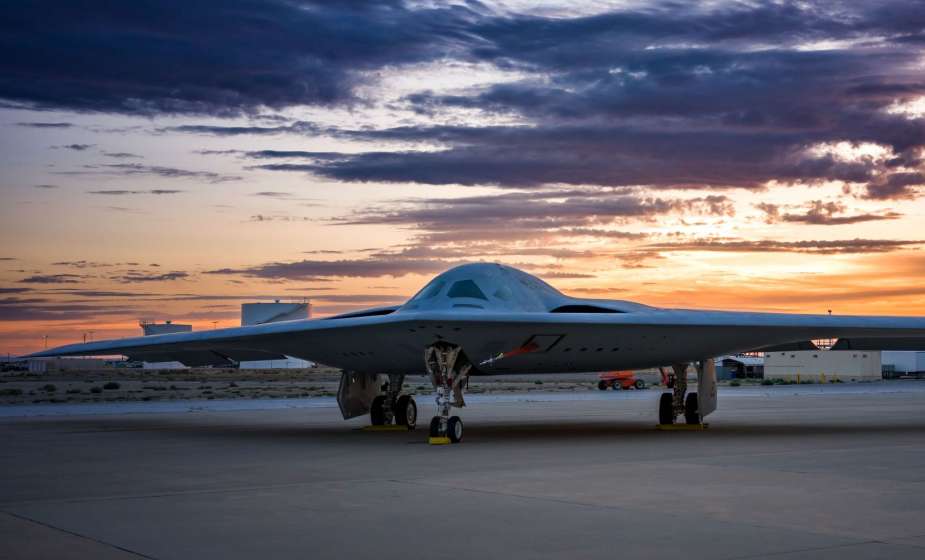Breaking news
Northrop Grumman starts production of sixth-generation B-21 Raider stealth bomber.
On January 22, 2024, the U.S. Department of Defense marked a significant milestone by commencing low-scale production of the Northrop Grumman B-21 Raider stealth bomber, Airforce Technology reports. This cutting-edge aircraft is being assembled at the U.S. Air Force Plant 42 in southern California, where six additional units are currently in various stages of construction. This momentous event marks the culmination of the Long Range Strike Bomber (LRS-B) program, which had its inception back in 2011 to create a sixth-generation stealth bomber.
Follow Air Recognition on Google News at this link
 The B-21 Raider is poised to assume the vital roles currently undertaken by the B-1 Lancer and the B-2 Spirit (Picture source: Northrop Grumman)
The B-21 Raider is poised to assume the vital roles currently undertaken by the B-1 Lancer and the B-2 Spirit (Picture source: Northrop Grumman)
The B-21 Raider is poised to assume the vital roles currently undertaken by the B-1 Lancer and the B-2 Spirit, Airforce Technology recalls, positioning itself as the primary stealth bomber within the U.S. Air Force's extensive arsenal. Despite its pivotal role, a shroud of secrecy envelops the B-21, concealing essential details that include its exact measurements, structural composition, top and cruising speeds, operational ceiling, engine specifications, prospective armaments, onboard systems, and sensory equipment. Yet, its notoriety primarily stems from its advanced stealth capabilities. The B-21 has been intricately engineered to minimize radar signatures, going to extraordinary lengths such as incorporating unique cockpit windows to eradicate seams and joints. Furthermore, it is anticipated that the B-21 will be equipped to carry nuclear-armed weapons.
Cost efficiency is a standout attribute of the B-21 program. Originally estimated at approximately $550 million per unit in 2010 dollars, adjusting for inflation places it at around $750 million per unit, representing a substantial reduction when compared to the B-2 bomber, which had a staggering unit cost of $2 billion. This economic advantage can be attributed in part to the application of advanced radar-absorbent materials, not only enhancing stealth capabilities but also curbing maintenance expenditures, Airforce Technology writes.
The element of economies of scale plays a pivotal role in the B-21's cost-effectiveness, with a total of 100 units ordered, marking a substantial increase in production compared to the 20 B-2s manufactured. Additionally, aerospace and stealth manufacturing advancements over the past three decades have streamlined production, rendering it more efficient and cost-efficient. Nevertheless, the precise financial figures about the B-21 program remain classified, even to members of Congress.
The veil of secrecy enveloping the B-21 program is a response to concerns about likely espionage and hacking threats, particularly in light of past incidents involving Chinese operatives gaining access to F-35 designs. As recalled by Airforce Technology, in 2009, the Joint Strike Fighter program, responsible for developing the F-35, fell victim to a data breach. Subsequently, when China unveiled its J-31 fighter in 2012, striking parallels with the F-35 raised suspicions of stolen design principles. To counter such risks, the B-21 program adopts a level of secrecy consistent with other stealth aircraft developments.
The B-21's advanced stealth capabilities empower it to conduct deep strike missions against targets that were previously impervious to attack. Moreover, it has the potential to function as a signals intelligence (SIGINT) platform, conducting high-altitude, long-range reconnaissance, and intelligence collection missions. Additionally, the B-21 may possess the capability to undertake airborne early warning and control (AEW&C) missions, offering superior survivability compared to existing Boeing E-3 aircraft.
Furthermore, the B-21 assumes a pivotal role in U.S. network-centric warfare concepts. In hypothetical strike scenarios, the B-21 can collaborate with other highly networked aircraft, such as the F-35, which operate at lower altitudes and speeds. In such scenarios, the B-21 can provide longer-range guidance systems to direct weapons launched by the F-35 toward their intended targets. Significantly, the B-21 stands out as the world's first aircraft capable of both manned and remote operation.
The emergence of the B-21 has already provoked responses from other nations, Airforce Technology reports. Chinese researchers have proclaimed that their advanced hypersonic missiles, with speeds reaching up to Mach 6, can intercept B-21s in simulated war games. While the B-21 does not attain such velocities, its sophisticated stealth features are specifically engineered to thwart any potential missile targeting.


























